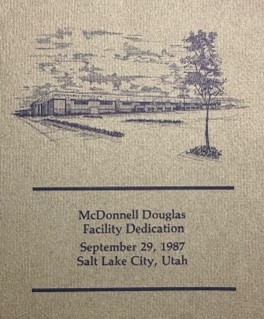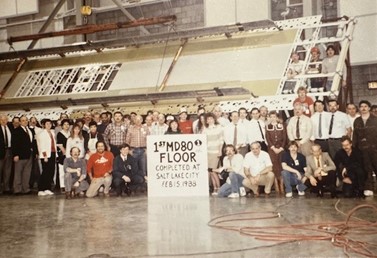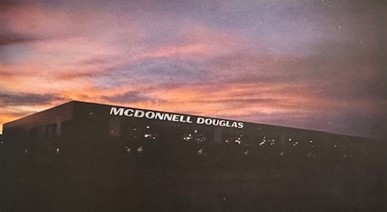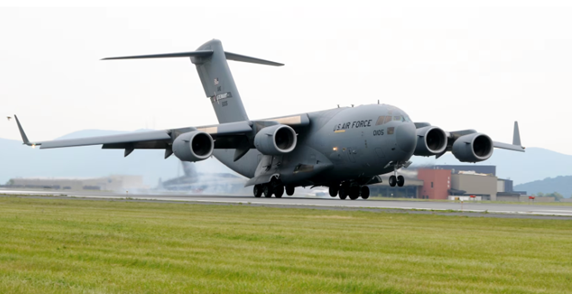“I’ll vote for it if you’ll put a plant in Salt Lake City.”
In the early 80’s, the new Rough Field-Short Take Off C–17 transport plane was stuck in the Senate Appropriations Committee. Senator Orrin Hatch (R-Utah) was saying it was too expensive and not critical to the defense of the country. McDonnell Douglas was the winner of the design competition and was anxious to get started on the fat military contract.
In exchange for a YES vote from Senator Hatch, Douglas constructed a multimillion-dollar building on the mud flats that surround the Salt Lake International Airport. Without a purpose in mind, it was 160,000 square feet of “assembly area,” 12,000 feet of “office,” and 21,000 feet of “support area” … basically a big square building with nothing in it.

I was working for Honeywell at the time, selling maintenance contracts on heating and air conditioning (HVAC) systems. Since the building had all Honeywell controls, I approached the Douglas people (all 5 of them) about doing an HVAC maintenance contract. I told my boss what I was doing and he said,“Why don’t you pitch them on maintaining the whole building.”
I said, “You mean on ALL the equipment in the WHOLE building.”
He said, “Sure, for the right money, we’ll maintain anything.”
For the next week or so, I crawled around the building’s mechanical spaces writing down model and serial numbers on overhead cranes, boilers, compressors, anything that moved or made noise. I was basically writing the maintenance manual for the building.
At the end of my slide show/sales pitch in the empty lunchroom, the plant manager said, if I ever wanted to leave Honeywell to come see him.
“Let’s talk,” I said. That is how I became the sixth person hired at Douglas Salt Lake.
At about this time, the labor unions representing Douglas workers in Canada were threating to strike. They made the floor panels for Douglas’s biggest seller, the MD-80, and a strike would stop production of that very profitable aircraft. Someone at our Long Beach headquarters said, “Why don’t we move the assembly jigs to Utah, which is a right to work stare (that’s code for no unions) and let them assemble the panels.”
Hooray! We had something to do besides keeping the place clean.
When the jigs arrived, I looked at the I.D. plate and found they were constructed in 1958! The same floor was used in the DC-8, the Stretch-8, the DC-9, and now the MD-80 and soon the MD-90. The floor had gone from 4 props mounted on the wings to 2 jets mounted on the tail. Working for an aerospace giant, I had expected to see carbon fiber, titanium, and who knows what else. Surprise!
Now that we were “in production,” the plant manager thought it would be wise to have some machinery out on the floor, for looks if nothing else. He sent me to Long Beach to comb through the Douglas “bone yard,” which was several acres of mostly World War II era machinery, sitting outside, that no one had the heart to throw away. Precomputer-age drill presses, Bridgeport milling machines, sheet metal brakes, tube benders, you name it, we got it. When a flatbed semi-trailer chock full of WW II machinery arrived in Salt Lake, I thought, All these old veterans have a soul, and I’m going to give them a second chance!
Company policy said we had to build a chain link fence around our new shop. I asked Personnel, oops, I mean Human Resources, to keep an eye out for people to staff it. Showing up for an interview with grease under your fingernails was considered a plus.
We also built a fence around what would soon be the parts storage area. Douglas had adopted the then-fashionable “Just In Time” (J.I.T.) management theory. Parts were delivered within hours–or, at most. days–of when they were needed. They were also touting the “Total Quality Management” theory (T.Q.M. of course), which basically said, Do It Right The First Time.
We’ll see how all that worked out.
Without too many hiccups, we assembled our first floor panel and shipped it by flatbed to Long Beach. Most of the parts were made in Long Beach and shipped to us for assembly. Ain’t congressional politics great!

I’d often come to work in a suit & leave in coveralls.
People being people, sometimes a part was ruined–or “butched,” in the lingo. “I drilled the hole in the wrong place,” or “I drilled a big hole when I should have drilled a little one.” With hundreds of parts and thousands of hand operations, the laws of chance said you would screw up eventually. By failing to account for the humanness of what we were doing, we set ourselves up for failure.
Since there were no backup parts, we were stuck (J. I. T. and all that). Delays weren’t to be tolerated (T.Q.M. and all that) so what were we to do? In the best of Yankee ingenuity, the crew on second shift arranged for a hole to be cut in the parts cage and a roll away tool box conveniently placed against the hole inside, with a matching tool box placed against the hole outside to mask the new portal. A “scout” would access the cage late on second shift to find a part that, with a little love from our freshly cleaned and refurbished machine shop, could be substituted for the butched part. Little Suzy can keep her job, and vows to do better next time. Of course, when the schedule said it was time to deliver the previously purloined part, nobody knew nuthin’.
If I, as a lowly facilities guy, knew about the underground railway, I’m sure somebody in management was wise to it too.
Apparently, this and similar problems were widespread within the company. By failing to account for us humans, the soul of the company was lost, and problems multiplied. The solution was to create TIGER TEAMS, usually made up of hard living, hard drinking, multi-year or even multi-generational Douglas employees. TIGERS would jump on a Douglas private jet, show up at the offending Douglas plant or supplier, and with a combination of profanity and arm waving solve any problem.
After three years, I got tired of TIGERS and of playing the game and left.

When Boeing married the nearly bankrupt Douglas in a shotgun wedding overseen by the defense department, the Douglas team took over Boeing. The current Boeing C.E.O. and most of the top management are Douglas alums. Milton Friedman once famously said, “The business of business is to maximize profits.” and Milton’s philosophy fit Douglas perfectly. Apparently, Boeing bought into it too and let the Douglas folks run the show. By focusing purely on profits, they killed the soul of the company.
That could explain the aircraft parts, and whole airplanes falling from the sky. Let’s hope Boeing sees the error of their ways…and soon.

